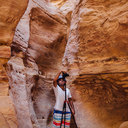0 Likes
Works by Eisaku Ando - Where the Soul Goes
March 11, 2011 was a day for Japanese people when the values of ordinary people's lives were radically shaken. It was the day the Great East Japan Earthquake occurred. After the Great East Japan Earthquake, Eisaku Ando and his family moved to Tenri City in Nara Prefecture, where he now resides. When I asked Ando why he came to Nara after the disaster in Fukushima, he replied, "Because there are many good Buddhist statues in Nara". Hearing these words, I thought that Nara was where his soul wanted to go. Then I remembered the documentary film "Enku and the Ainu" (1965 Nikkei Video: Poetry of Japan) supervised by the traveling folklorist Miyamoto Tsunekazu. It was not just because Ando won the Enku Prize, but also because Enku, who traveled around Japan during the Edo period, spread Buddhism by carving Buddhist statues and traveled as his spirit took him. Enku traveled to Hokkaido, where the Ainu people lived in the farthest reaches of the country.
The Ainu people must have said to Enku.
"We have Kamui. That is why we cannot take refuge in your Buddhism, but your character and your Buddhist statues are wonderful." In fact, an old document from the Edo period says that the Ainu people dedicated salmon and other fish to Enku.
Since moving to Nara, Ando has produced many works at a phenomenal pace. He continued to throw the rubble of his works at contemporary Japanese society. He is also fighting a lawsuit against the Fukushima nuclear power plant with his friends in Kansai. I had a chat with Ando in his studio, who maintains such a fighting attitude.
He said, "In a good sculpture, you can see the lines of energy not on the surface of the work, but inside!" What is the line of energy in the work? Is it the life force of the work? Ando has studied sculptures from both the East and the West very carefully. Ando's criteria for judging a work of art seems to be the existence of a line of energy within the work. He himself creates his works by beating wood with an axe. When I watch him, I can't help but think that he is injecting energy from his axe into the wood. He uses several types of axes, from the roughing axe to the finishing axe, as he works.
By the way, don't artists create their own system of production to create their own works, and also create a history of sculpture (art history) through their production? Ando's unique history of sculpture was born from his production. What flows at the bottom of his sculptural history may vary from life in Fukushima to anger at the government's policy of nuclear power generation.
As I was leaving his studio, I remembered something. As I left his studio, I remembered something he said to me at his previous solo exhibition in Nara.
He said, "I have lived the last ten years with many thoughts and feelings, but what I want to say now is to 'forgive' everything.
I would like to witness the world of Eisaku Ando's works, which led to the word "forgiveness," in the space of Kyoto Place.
Yasuo Nakano, Director, Kyoto Place
Japanese sculptor. Creates works using a technique of carving logs by beating them with a hatchet. He is a surfer. His wife is Hiroko Hasegawa, a sculptor.
Our mission is to create a "Ba (place)" where free expression is allowed and encouraged.
...





The eight islands of Japan sprang into existence through Divine Intervention.The first two gods who came into existence were Izanagi no Mikoto and Izanami no Mikoto, the Exalted Male and Exalted Female. It was their job to make the land for people to live on.They went to the bridge between heaven and earth and, using a jewel-encrusted halberd, Izanagi and Izanami churned up the sea into a frothy foam. As salty drips of water fell from the tip of the halberd the first island was formed. Its name was Onogoro.So far, so good. But when Izanagi and Izanami first met on their island, Izanami spoke to Isanagi without being spoken to first. Since she was the female, and this was improper, their first union created badly-formed offspring who were sent off into the sea in boats.The next time they met, Izanagi was sure to speak first, ensuring the proper rules were followed, and this time they produced eight children, which became the islands of Japan.I'm sure you did not fail to miss the significance of this myth for the establishment of Japanese formal society.At present, Japan is the financial capital of Asia. It has the second largest economy in the world and the largest metropolitan area (Tokyo.)Technically there are three thousand islands making up the Japanese archipelago. Izanagi and Izanami must have been busy little devils with their jewelled halberd...Japan's culture is highly technical and organized. Everything sparkles and swooshes on silent, miniaturized mechanisms.They're a world leader in robotics, and the Japanese have the longest life-expectancy on earth.Text by Steve Smith.